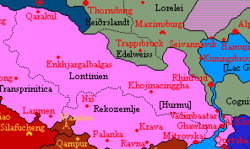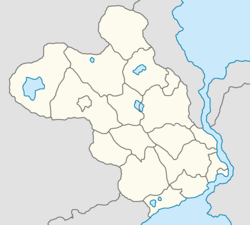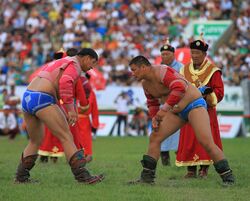Lontinien
| Londin Uls Löndınstan Лонтинија / Lontinija Lontinen Lontinien | |||
| |||
| Motto: | |||
| Anthem: | |||

| |||
| Map versions | |||
| Capital | Ghawlama | ||
| Largest city | Khojinacinggha, Mitrovska, Vadimbaatar | ||
| Official language(s) | Istvanistani White Lontinian Blue Lontinian Hurmu Norse Crandish Krasnocorian | ||
| Official religion(s) | None official; Traditional Lontinian practices granted cultural protection | ||
| Demonym | Hurmudan(s) | ||
| - Adjective | Hurmu | ||
| Government | Constitutional state | ||
| - Khan | Temüjin | ||
| - Chairwoman of the Executive Council | Ghawetkiin Enkhjargal | ||
| - Legislature | The Great Yurt | ||
| Establishment | 1689 (restoration) | ||
| Area | |||
| Population | 3,884,971 (1694 AN) | ||
| Currency | Craitish Cräite (CRC) | ||
| Calendar | |||
| Time zone(s) | CMT+1 | ||
| Mains electricity | |||
| Driving side | left | ||
| Track gauge | |||
| National website | |||
| National forum | |||
| National animal | Horse, Yak | ||
| National food | Yoghurt, cheese | ||
| National drink | Tea | ||
| National tree | Wildbush | ||
| Abbreviation | Lont. | ||
Lontinien (White Lontinian: Londin Uls; Blue Lontinian: Löndınstan; Krasnocorian: Лонтинија, Lontinija; Hurmu Norse: Lontinen) is the part of Hurmu on the Apollonian continent, on the mouth of the River Glacei. It is populated by Lontinians (Jawnetka) and people belonging to the Eastern Ulus of the Silver Yak Horde. The Jawnetka are a traditionally peaceful people, unlike their brethren in the Yak Horde. This lifestyle brought the affinity of the Hurmudans and they became friends, allies and brothers ever since. In 1694, the Eastern Ulus of the Silver Yak Horde swore their fealty to the Khan of Lontinien and Lontinien thus assumed that Ulus's territory from the Green.
The name Lontinien is Crandish in origin, and is derived from the old, long-since ruined, city of Londina, one of the few cities of the Jawnetka in pre-historic times.
Lontinien was in its early days confused with Tartary (later known as Eesdeheito), and the two names became synonymous with one another. Their cultures and languages have much similarity, and their histories have interlinked one another through subjugation in Cranda and Stormark.
Geography
Lontinien is generally flat, with some cliff formations in the north towards the border to Lac Glacei. Forests are rare, though exist in the far southern regions of the District. The land is steppe-like and generally not well suited for growing crops.
Lontinien's border is in the process of being demarcated and secured. Most of the it, generally, to the west, borders the lawless Green. To the north of Lontinien is Lac Glacei, with a secure and peaceful border. To the south is the border to Çakaristan, also a secure and peaceful border.
Lontinien lies along the southern half of the western bank (right bank) of the River Glacei. Across the river, on the eastern (left bank) is Arbor. As of now, only ferries allow for access between Arbor and Lontinien. There are informal discussions between Hurmu and Arboric diplomats on constructing a crossing between Ghawlama and the outskirts of Al-Kadra.
Ghawlama is the capital city of Lontinien, and the only real port. Ghawlama also is a toll port for access up and down the River Glacei. The largest city in the district, however, is Khojinacinggha. Other important towns of note are Mitrovska and Vadimbaatar.
History
Lontinien is probably one of the oldest parts of Micras. It used to be a nation of its own before being annected to Cranda (before Menelmacar even existed). Later, the culture of Lontinien merged with that of Tartary and the storyline developed: Apollonian Tartars spoke a Mongolic language (not a Turkic) and placenames reflected that. Tartary has since been reduced to the small part of Lontinien by the River Glacei, but it's city still has a Mongolic name: Ghawlama, "the river-mouth".
- Founded in North Cranda as Londina
- Moved to the island as Lontinien in 6.5.0.
- Crandish–Arminian era
- Hurmu
- Stormark
Timeline
1599–1603: Part of The Dominion
1606: Lakkvia formed as part of Craitland, Ghawlama occupied by Jingdao
1607: Outside Ghawlama, Lontinien under Cheltia
1614: Cheltia collapses, Ghawlama remains under Jingdaoese rule
1615: Toketi (Gralus) claims the former Cheltian parts of Lontinien, Jingdao leaves Ghawlama to the Green
1627: Jingdao retakes Ghawlama after 12 years in the Green
1628: Gralus (Toketi) collapses. Stormark sets up a Lontinien khanate outside the Ghawlama region (which, expanded, remains under Jingdaoese rule)
1631: Ghawlama is ruined
1632: Jingdao collapses, loses its continental lands, remains on a few islands. Later the same year, Stormark takes Ghawlama from the Green and establishes a government, rebuilds the city, and expands the Lontinien region, which it holds until 1685 when Stormark collapses.
Period in Stormark
Hurmu independence
- 1689: Lontinien joins the Hurmu Trust Territory, its Khan, Temüjin, becomes co-ruler of Hurmu
- 1690: Lontinien becomes part of the newly restored state of Hurmu.
- 1691:
- 1692:
- 1693:
- 1694: With the Eastern Ulus of the Silver Yak Horde swearing their fealty to the Khan of Lontinien, and thereby their allegiance to the state of Hurmu and the Order of the Holy Lakes, Lontinien's territory expanded to include the territory under the dominance of the Eastern Ulus (centred in Khojinacinggha). As such, Lontinien's population increased by 3.17 million people speaking a Lontinian dialect. Moreover, at the same time, Lontinien expanded to integrate Mitrovska into it, after the population there had asked for Hurmu's aid in pacifying the city and restoring it to order. As such, some 150,000 people of the Corian tongue were added to the population of Lontinien.
Languages
The Lontinian nation consists of two major languages, White Lontinian (Jawnetka) and Blue Lontinian (Tartar). These languages, although sharing similar names and having co-existed in the Lontinian nation for centuries, are not genetically related at all. Blue Lontinian, historically also known as Tartar, is more closely related to Çakari, Thraci and Hazarese than it is to White Lontinian. Of the ethnic Lontinian nation, three fifths have White Lontinian as their native language, while two fifths have Blue Lontinian.
Thereafter, Krasnocorian and Crandish are large minority languages in Lontinien. Krasnocorian is spoken by approximately 10% of the entire population of Lontinien, but are geographically centred in the Mitrovska area. The main cultural organization for the Krasnocorian population is the Society of Yeshua. Crandish is spoken in pockets in western Lontinien.
| Home language | Number | Percentage of total |
|---|---|---|
| White Lontinian | 2,214,790 | 52.76% |
| Blue Lontinian | 1,140,952 | 27.18% |
| Krasnocorian | 448, 938 | 10.69% |
| Hurmu Norse | 164,184 | 3.91% |
| Crandish | 162,058 | 3.86% |
| Craitish | 5,209 | 0.12% |
| Lakkvian | 3,201 | 0.08% |
| Hurmumol | 105 | 0.00% |
| Other | 58,284 | 1.39% |
Sport
Lontinian sports are usually defensive sports. Lontinian people like to play their traditional sports instead of popular sports, the most popular sport in the region is wrestling. Wrestling is very popular in the terrioty, people of the terrioty play many variants of wrestling. But the most played type of wrestling is Khuresh. Khuresh, which has a name that is extremely similar to the Thraci language, is often played in Eastern Lontinien. Another popular sport is archery, a lot of skilled archers emerge from this terrioty. The Lontinian people are a community that loves horseback riding, and almost all Lontinian people know how to ride. In addition, an annual festival called Balaan is held and the Lontinian revelers do not miss this entertainment. Traditional sports are played in this festival and the athletes show their skills. The government built many stadiums for Balaan and other multi-sports.
Football and similar sports are young and less played in this region, football was very popular in the former Krasnocorian lands. There used to be a football club in Mitrovska, the stadium with a capacity of 30,000 is still standing in Mitrovska.



